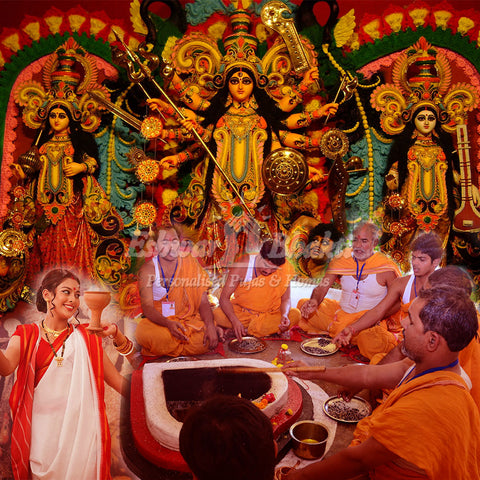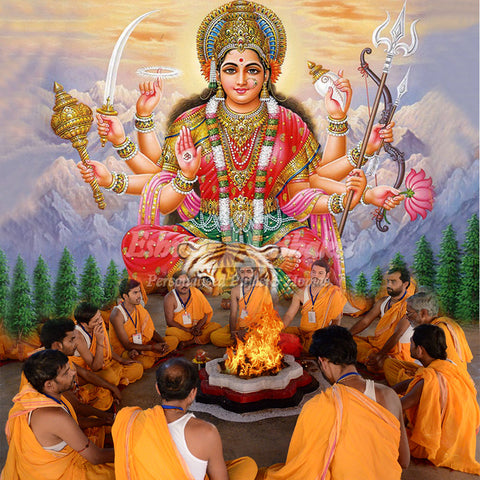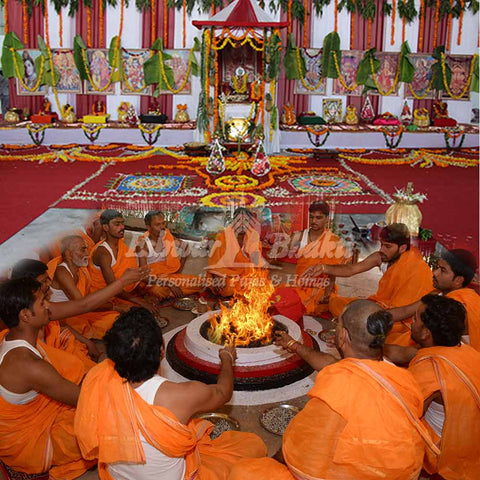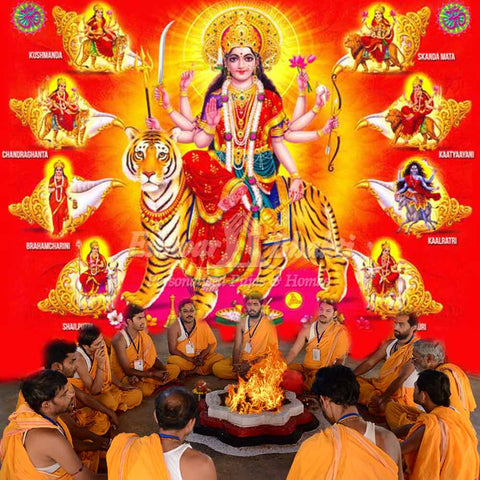Goddess Durga
 Durga Ma, identified as the principal form of Goddesses Parvati, she is considered to be the goddesses of war, responsible for combating evil and demonic forces that threatens the peace, prosperity and Dharma (considered to be the power of good over evil). With her ten weapon she triumphantly destroyed the evil Mahishasura, In the form of SATI, beloved daughter of King Daksha and Queen Menaka she gives up a kingdom and earns her father's wrath. In the form of Ma KALI, she turns black as the night and omnipotent, terrible in rage and fury, with just a string of skulls as her garland and her only garb. As Parvati, she is serene, the pretty consort of Lord Shiva by his side in the snowy peaks of the Kailash mountain. She is Bhawani, symbol of life. She is Sati, the object of death. She is Basanti, the heralder of springtime. She is also Amba, Jagadhatri, Tara, Ambika, Annapurna.
Durga Ma, identified as the principal form of Goddesses Parvati, she is considered to be the goddesses of war, responsible for combating evil and demonic forces that threatens the peace, prosperity and Dharma (considered to be the power of good over evil). With her ten weapon she triumphantly destroyed the evil Mahishasura, In the form of SATI, beloved daughter of King Daksha and Queen Menaka she gives up a kingdom and earns her father's wrath. In the form of Ma KALI, she turns black as the night and omnipotent, terrible in rage and fury, with just a string of skulls as her garland and her only garb. As Parvati, she is serene, the pretty consort of Lord Shiva by his side in the snowy peaks of the Kailash mountain. She is Bhawani, symbol of life. She is Sati, the object of death. She is Basanti, the heralder of springtime. She is also Amba, Jagadhatri, Tara, Ambika, Annapurna.
Goddess Durga represents the power of the Supreme Being that preserves moral order and righteousness in the universe. She is the energy aspect of the Lord. Without Durga, Lord Shiva has no expression and without Shiva, Durga has no existence. Lord Shiva is only the silent witness. He is motionless, absolutely changeless. He is not affected by the cosmic play. Shiva has no direct connection with the tangible elements in the universe and is obliged to emanate a manifestation, an emission of energy, shakti, through the goddess. It is Durga who is the doer of all actions. Shiva and Durga are regarded as the twofold personalization of Brahman, the primeval substance.
The Sanskrit word Durga means a fort, or a place that is protected and thus difficult to reach. Durga, also called Divine Mother, protects mankind from evil and misery by destroying evil forces such as selfishness, jealousy, prejudice, hatred, anger, and ego.
Origin of Goddess Durga: The historian Ramaprasad Chanda stated in 1916 that Durga evolved over time in the Indian subcontinent. A primitive form of Durga, according to Chanda, was the result of "syncretism of a mountain-goddess worshiped by the dwellers of the Himalayas and the Vindhyas", a deity of the Abhiras conceptualised as a war-goddess. Durga then transformed into Kali as the personification of the all-destroying time, while aspects of her emerged as the primordial energy (Adya Sakti) integrated into the samsara (cycle of rebirths) concept and this idea was built on the foundation of the Vedic religion, mythology and philosophy.
Epigraphical evidence indicates that regardless of her origins, Durga is an ancient goddess. The 6th-century CE inscriptions in early Siddhamatrika script, such as at the Nagarjuni hill cave during the Maukhari era, already mention the legend of her victory over Mahishasura (buffalo-hybrid demon).
Significance of 10 weapons of Goddess Durga
Durga Ma with her fearless gestures and spirit to fight against the treacherous evil Mahishasura, for 9 long day and she took 9 different forms (often called NavaDurga) to kill him. She used 10 weapons given by the deities to defeat the evil and bring the spirit of hope. She represents every woman across the nation with their words, there power to hold the weapon and retaliate.
• The first weapon is the Sword, given to her by her son Lord Ganesh.
Significance: The Sword represents intellect and wisdom. The weapon is usually carried by those who have a sense of responsibility and who fight to retaliate against the odd. This mighty sword which forms the major weapon Durga Ma possesses suggests that man should get rid of his illusions and needs which bind his soul and prevents him from doing or experiencing the real duties. Basically, a sword signifies the blend of incomprehension and intellect which overcomes with negativity.
• The second weapon is the Trishula (Trident), given by her trident Lord Shiva
Significance: The three points of the Trishula represents the past, present and the future. The centre of the Trishula represents the soul that should never remain above the past and the future, since the past is gone and the future is uncertain. Therefore, the person should live with awareness every moment so to be find the details in the grains of sand.
• The third weapon is the Sudarshan Chakra, given by Lord Vishnu.
Significance: The chakra represents the sphere of life which keeps on revolving till we are alive. It says its people that time destroys everything but with inner awakening one goes beyond time.
• The fourth weapon is Vajra (Thunderboult), given by Lord Indra.
Significance: It symbolises the firmness of spirit, determination and supreme power. The Hindu tradition earnestly believe that Durga Ma gives confidence and will to all it devotes without losing the inch of hope.
• The fifth weapon is Tir-Dhanush (Bow and Arrow), given by Lord Vayu.
Significance- The bow and arrow is one of the oldest weapons used since time immemorial, it is also one of the powerful. The arrow held by Ma Durga represents that people should be steady and focused towards their goal. They should be clear about what they aspire for and should work accordingly to achieve it.
• The sixth weapon is Spear/Javelin, given by God Agni.
Significance: The spear symbolizes auspiciousness; it also represents pure and fiery power. It signifies the hidden power of human to overcome all the obstacles of life and so the shield is the weapon that protect oneself from attack. The human should keep away from the wrong and fight against it accordingly with determination.
• The seventh weapon is Shankh, given by Lord Varuna.
Significance: The Shankh is the symbol of primordial sound of creation i.e. Aum. It represents the power to eliminate all the negative forces on the planet.
• The eighth weapon is Lotus, given by Lord Brahma.
Significance: It represents wisdom and liberation of knowledge. It represents devotion and surrender. The person whatever he does should put love and devotion to it, and leave it for the good outcome on almighty’s will.
• The ninth weapon is Club or Axe, given by Lord Vishwakarma.
Significance: It symbolises no fear of consequences when fighting the evil, as the axe will kill the evil and bring peace on the stand.
• The tenth weapon of Ma Durga is her companion or Bahana (in Bengali) the Lion, given by Lord Shiva.
Significance: Lion is the king of all animals and is, in fact, the most powerful. Goddess Durga rules the existence by making a lion her Bahana. This signifies that one should keep their strengths and powers within one’s control and let it rise when required.
Significance of the ten days of Durga Puja :
• First day: The festival begins with Mahalaya, a day where Shakta Hindus remember the loved ones who have died, as well the advent of Durga. This is typically also the day when the eyes of all deities on the Durga Puja stage are painted, bringing them to a life like appearance. The festival opens at twilight with prayers to Sarasvati & Ganesha. People also visit to several Durga temples.
• Second - Fifth Day : The aspects of Goddess Durga: - Kumari (Goddess of Fertility), Mai(mother), Ajima(Grandmother), Lakshmi(Goddess of wealth), Saptamatrikas (seven mothers), Navadurga(nine aspects of Durga) are remembered & worshipped.
• Sixth day (Shashti) : This is the beginning of major festivities & social celebrations Goddess Durga is welcomed & celebrations begin in temples and pandals. This is called Bodhana. The puja rituals are long and complicated. Three days of Mantras, Shlokas chants and Arati. Offerings are also made, which include Vedic chants and multiple recitations of the Devi Mahatmya text in Sanskrit.
• Seventh day (Saptami) : On this day following rituals are performed:
Bathing of Goddess, selection of priest, Aarti, recitation of texts describing Durga heading to war, group meditation, screams like crying at high points by women
• Eighth Day (Mahasthami): The celebrations are almost similar to seventh day. It is a significant day because the moment when the eighth-day ends and ninth day begins is considered as the moment when Durga kills the demon, Mahishasura.
Sandhi Puja: It is forty-eight minute high point ritual that celebrates the climax of war. The ritual is performed at last 24-minutes of Mahashtami & first 24-min of Mahanavami.
• Ninth-day (Mahanavami) : It is similar to seventh day the only difference is it is a celebration after victory of Goddess Durga.
• Tenth-day (Vijaya – Dashami) : The festival ends on this day. It begins with Sindoor Khela where married women smear Sindoor on Durga’s forehead & feet, then on each other. A procession is initiated by Shakta Hindu communities with drum beats of music & mantra chants. A colorful clay statue is carried & then immersed into river or sea.
Durga is thus believed to return to Mount Kailash with Shiva and thus, the wait for Ma Durga prevails for next year again.








